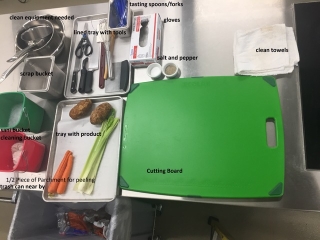
A Place for Everything and Everything in Its Place
03 September 2024Teach the benefits of mise en place from day one.
By Dr. Jennifer Denlinger, CCC, CHEP
Feedback & comments: This email address is being protected from spambots. You need JavaScript enabled to view it.
Instructors understand how mise en place helps create success in our lives, not only in the kitchen but beyond the kitchen doors. We place and pull orders, set up stations, set up the dish machine, pull tools and ingredients for demos and it all begins with mise en place. From start to finish, mise en place is firmly entrenched in culinary routines. We need to teach our students these values on the first day of kitchen lab.
I begin with a very detailed mise en place sheet. (The first time another instructor saw my mise en place sheet they looked at me with puzzlement. After understanding the system their eyes turned to a look of amazement.) Another time, a student asked me to check their recipe conversions with mine. I said sure and handed this person my mise place sheet with the correct amounts. The student looked scared and I laughed. I showed this person how I include this on my sheet and after that the student started following my format.
When organizing my mise en place sheet, my goal is to touch ingredients only once or for the least amount of time possible. For instance, if I need to measure flour, I will do it once. Period. I sort my sheet alphabetically and it is easier for me to pull and prep ingredients. For international cuisine, I may include abbreviated procedures or notes on important steps I need to remember.
I organize the ingredients on the tray(s) in the order I need to use them. Sometimes I might have a refrigerated and room-temperature tray. Every item is accounted for from the tools to sani and cleaning buckets.
We must teach these successful routines to students. How do you set them up for success and help them understand the key is mise en place? I start from the very, very first lab class. I use my mise en place sheet and locate one by one all the tools, ingredients and other pertinent items required. I set up my station from scratch and then I mise en place from scratch.
I do this for several labs during the first part of the semester. My students become very cognizant of the time it takes to accomplish mise en place. I always demonstrate peeling, chopping, dicing, and other pre-prep steps. As they move along in the curriculum and their skills get stronger, I complete more of the pre-prep items if warranted and directly go to the cooking, baking and plating part. This allows students more time to accomplish their lab and reduces the time they listen to me. Eventually, I add a refresher on how to set up the station, use the dishwasher, etc. at the beginning of the lab.
These are a couple of tricks I learned for mise en place. Take a look at my examples and maybe it will work for you too.
Attachments:
Sample savory mise en place sheet
Sample baking mise en place sheet
Mise en place template document
Chef Jennifer M. Denlinger, PhD., CCC, CHEP, is the Culinary Management Program Department Chair at the Poinciana Campus of Valencia College. She is also the vice president of ACF’s Central Florida Chapter. Additionally, Chef Denlinger earned the 2020 Innovation Award, sponsored by CAFÉ and the Idaho Potato Commission, for a creative escape room based on safe food handling procedures. She also earned the 2021 Green Award sponsored by the United Soybean Board and was runner-up in 2021 for the Postsecondary Education of the Year sponsored by Sysco Corporation.
